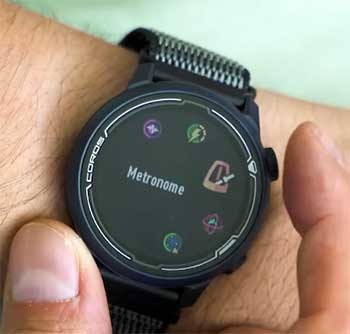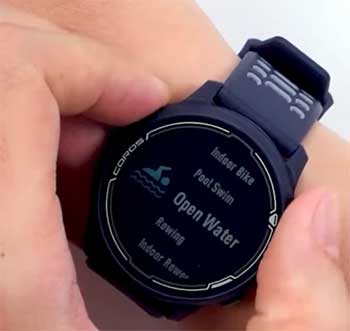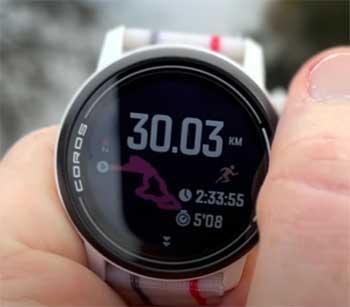I’ve been lacing up my running shoes and hitting the trails, roads, and tracks for years, and a reliable sports watch is my trusty sidekick. When it comes to affordable, feature-packed options, the Coros Pace 2 and Pace 3 stand out.
In this article, I’m breaking down their differences, weighing the pros and cons, and sharing my firsthand experience to help you decide which one suits your needs. Whether you’re a casual jogger or an ultramarathoner, let’s find out which watch keeps pace with your goals.
A Brief Comparison Table
| Feature | Coros Pace 2 | Coros Pace 3 |
| Price | $199 / £179 | $229 / £219 |
| Weight | 29g (nylon), 35g (silicone) | 30g (nylon), 39g (silicone) |
| Display | 1.2″ LCD, 240×240, no touchscreen | 1.2″ LCD, 240×240, touchscreen |
| Battery Life | 20 days (smartwatch), 30h (GPS) | 24 days (smartwatch), 38h (GPS) |
| GPS Modes | GPS-only | GPS-only, All Systems, Dual Frequency |
| Heart Rate Sensor | Basic optical | 5-LED, 4-photodetector |
| Music Storage | None | 4GB (MP3 only) |
| SpO2 Monitoring | No | Yes |
| Wi-Fi Connectivity | No | Yes |
| Strap Size | 20mm | 22mm |
| Water Resistance | 5 ATM (50m) | 5 ATM (50m) |
| Navigation | Basic breadcrumb (post-2023 update) | Breadcrumb navigation |
| Processor | Standard | Upgraded, faster |
| Storage | 64MB | 4GB |
My Journey With Coros Watches
As a distance runner who’s tackled everything from 5Ks to ultramarathons, I’ve relied on sports watches to track my progress, guide my training, and keep me motivated.
The Coros Pace 2 has been a staple in my gear rotation since 2020, and when the Pace 3 hit the market in 2023, I was eager to see how it stacked up.
I’ve worn both watches extensively, testing them on runs through city streets, forest trails, and even during pool sessions. My goal? To figure out which one delivers the best bang for your buck and whether upgrading is worth it.
Design and Build Comparison of Coros Pace 2 And Pace 3

Both the Pace 2 and Pace 3 are featherweights in the sports watch world, and I mean that literally.
The Pace 2 tips the scales at 29 grams with a nylon strap, while the Pace 3 is a smidge heavier at 30 grams.
With silicone straps, they’re 35 grams and 39 grams, respectively.
I barely notice either on my wrist, even during long runs or overnight sleep tracking.
The Pace 3’s slightly larger 22mm strap (compared to the Pace 2’s 20mm) feels a tad more secure, especially for heart rate accuracy, but both are comfortable for all-day wear.
The Pace 2’s fiber-reinforced polymer case feels sturdy despite its plastic build, and the Pace 3 follows suit with no significant design overhaul. Both sport a 1.2-inch always-on LCD display with a 240×240 resolution.
The Pace 3, however, adds a touchscreen, which I found handy for quick swipes through menus but not game-changing—old habits die hard, and I still lean on the rotating crown for navigation. The touchscreen can be toggled off, which is a nice touch if you prefer buttons.
Pros of Pace 2 Design
- Ultralight at 29 grams with nylon strap.
- Durable despite plastic construction.
- Simple, intuitive button and crown controls.
Cons of Pace 2 Design
- No touchscreen, which some might miss.
- 20mm straps limit band options compared to Pace 3.
- Display can look washed out in bright light.
Pros of Pace 3 Design
- Touchscreen adds flexibility for navigation.
- Slightly larger 22mm straps improve fit and HR accuracy.
- Improved display contrast for better readability.
Cons of Pace 3 Design
- Touchscreen responsiveness isn’t as smooth as premium watches.
- Still plastic, which might feel less premium.
- Slightly heavier with silicone strap.
Battery Life: The Endurance Edge
Battery life is where Coros shines, and both watches are marathoners in their own right. The Pace 2 boasts 20 days in smartwatch mode and 30 hours in GPS-only mode. I typically got about 10-12 days with daily runs and sleep tracking, which is impressive for such a compact device.

The Pace 3 steps it up with 24 days in smartwatch mode and 38 hours in GPS-only mode, dropping to 15 hours in dual-frequency mode.
In my tests, using All Systems mode for 6-7 hours of weekly running, I squeezed out 15-16 days on the Pace 3, compared to about 13-14 days on the Pace 2.
The Pace 3’s battery boost comes from a slightly larger 236mAh battery (vs. 220mAh in the Pace 2) and better power optimization.
I love that both watches have a battery usage mode in the settings, showing you what’s draining the juice.
For ultrarunners or backpackers, the Pace 3’s extra GPS hours could be a game-changer, but the Pace 2’s battery is no slouch either.
Pros of Pace 2 Battery
- Up to 20 days in smartwatch mode.
- 30 hours of GPS tracking for long sessions.
- Charges fully in about 2 hours.
Cons of Pace 2 Battery
- Shorter life compared to Pace 3.
- No dual-frequency mode, so no battery trade-off for accuracy.
Pros of Pace 3 Battery
- Best-in-class 24 days in smartwatch mode.
- 38 hours in GPS-only mode, ideal for ultras.
- Efficient even with touchscreen and new sensors.
Cons of Pace 3 Battery
- Dual-frequency mode cuts GPS life to 15 hours.
- Heavy use (e.g., music, always-on screen) reduces longevity.
GPS And Tracking Accuracy Comparison of Coros Pace 2 And Pace 3
As a runner, GPS accuracy is non-negotiable. The Pace 2 relies on GPS-only mode, connecting to GPS and QZSS satellites. It’s decent for open roads but can struggle in dense urban areas or under thick tree cover.

I noticed occasional distance discrepancies on my usual routes compared to my Garmin, which was frustrating.
The Pace 3, however, upgrades to All Systems and Dual Frequency modes, tapping into five satellite systems for better precision.
In my tests, the Pace 3’s GPS tracks were noticeably cleaner, sticking closer to my actual paths in forests and cities.
Heart rate tracking is another critical metric. The Pace 2’s basic optical sensor was hit-or-miss, especially during high-intensity intervals. I often saw spikes (like 170 bpm on an easy run) that didn’t align with my chest strap data.
The Pace 3’s upgraded 5-LED, 4-photodetector sensor is a step up, matching my Polar H10 chest strap more closely during steady runs. However, it still lagged during rapid intensity changes, a common issue with optical sensors. For pinpoint accuracy, I’d pair either watch with an external strap.
Pros of Pace 2 Tracking
- Reliable GPS for open areas.
- Decent heart rate for steady-state runs.
- Software updates (as of 2023) add breadcrumb navigation.
Cons of Pace 2 Tracking
- GPS struggles in cities or forests.
- Heart rate accuracy falters during intervals.
- No SpO2 or advanced altitude tracking.
Pros of Pace 3 Tracking
- Dual-frequency GPS for superior accuracy.
- Improved heart rate sensor for better consistency.
- SpO2 monitoring for altitude and sleep tracking.
Cons of Pace 3 Tracking
- Heart rate still lags during rapid intensity shifts.
- Dual-frequency mode drains battery faster.
- No real-time routable maps, only breadcrumb navigation.
Features and Functionality Comparison of Coros Pace 2 And Pace 3
The Pace 2 is a no-frills multisport watch with over 20 modes, including running, cycling, swimming, and strength training. It’s got the basics covered: pace, distance, cadence, and training load analysis.
Software updates in December 2023 brought features like breadcrumb navigation, making it more competitive. However, it lacks music storage, SpO2 monitoring, and Wi-Fi syncing, which can make activity uploads via Bluetooth sluggish.
The Pace 3 builds on this foundation with significant upgrades. The touchscreen, while not as slick as an Apple Watch, makes menu navigation easier. Music storage (4GB for MP3 files) is a big win for phone-free runs, though the lack of Spotify or Deezer support is a bummer.
SpO2 monitoring is a nice addition for high-altitude runners or sleep tracking enthusiasts, and Wi-Fi syncing speeds up data transfers. The Pace 3 also has a faster processor, making the interface snappier.
Pros of Pace 2 Features
- Comprehensive sports modes for multisport athletes.
- Affordable price for core tracking features.
- Regular software updates keep it relevant.
Cons of Pace 2 Features
- No music storage or playback.
- Lacks SpO2 and advanced health metrics.
- Bluetooth syncing can be slow.
Pros of Pace 3 Features
- Music storage for phone-free workouts.
- SpO2 and altitude mode for high-altitude training.
- Faster Wi-Fi syncing and processor.
Cons of Pace 3 Features
- No streaming music support (e.g., Spotify).
- Limited third-party app integration.
- Touchscreen not as responsive as premium watches.
Smart Features: Keeping You Connected

Neither watch is a full-fledged smartwatch, but they offer some connected features.
Both support notifications for calls and texts, though I found them basic—don’t expect to reply from your wrist.
The Pace 3 adds a weather forecast widget and music playback, which I enjoyed during long runs without my phone.
However, the drag-and-drop MP3 system feels dated compared to Garmin’s streaming integrations. The Pace 2, with no music or Wi-Fi, feels more stripped-down, but at $199, it’s hard to complain.
Pros of Pace 2 Smart Features
- Basic notifications keep you in the loop.
- Simple interface focuses on fitness.
Cons of Pace 2 Smart Features
- No music or weather features.
- Limited smart functionality.
Pros of Pace 3 Smart Features
- Music playback for phone-free runs.
- Weather widget and Wi-Fi syncing add convenience.
Cons of Pace 3 Smart Features
- No contactless payments or app store.
- Music limited to MP3 files.
Price And Value Comparison of Coros Pace 2 And Pace 3
The Pace 2, at $199, is a steal for its feature set. It’s ideal for budget-conscious runners who want reliable tracking without bells and whistles. The Pace 3, at $229, justifies its $30 premium with GPS upgrades, music, and SpO2.
If you snag a Pace 2 on sale (I’ve seen them as low as $159 open-box), it’s tough to beat. However, the Pace 3’s future-proofing—better hardware and more features—makes it a smarter long-term investment.
Pros of Pace 2 Value
- Cheapest multisport watch at $199.
- Great for entry-level runners.
Cons of Pace 2 Value
- May stop receiving updates sooner.
- Misses out on modern features.
Pros of Pace 3 Value
- Excellent value at $229 for advanced features.
- Future-proof with better hardware.
Cons of Pace 3 Value
- Slightly pricier than Pace 2.
- Not a huge leap for existing Pace 2 owners.
My Experience With Pace 2 And Pace 3
I’ve run hundreds of miles with both watches, and each has its strengths. The Pace 2 is like an old friend—reliable, simple, and always there. Its lightweight design and long battery life made it my go-to for marathons and daily training.
But its GPS quirks in tricky environments and lack of music were noticeable drawbacks. The Pace 3 feels like a refined version, with cleaner GPS tracks and music playback that kept me motivated on solo runs. The touchscreen was a nice bonus, but I often reverted to the crown for control.
For hiking, the Pace 3’s SpO2 and altitude mode were handy at higher elevations, while the Pace 2 felt basic in comparison. In the pool, both handled swim tracking well, with clear displays underwater.
If you’re starting fresh, the Pace 3’s upgrades make it the clear choice. But if you own a Pace 2 and it meets your needs, the differences might not justify an immediate upgrade.
Who Should Buy Which?
If you’re a new runner or on a tight budget, the Pace 2 is a fantastic entry point. Its core features rival pricier watches, and Coros’s software updates keep it relevant.
For ultrarunners, hikers, or those craving music and better GPS, the Pace 3 is worth the extra $30. Its advanced tracking and future-proof hardware make it a versatile pick for serious athletes.
Frequently Asked Questions (FAQ)
The Pace 3 is better for most users due to its improved GPS, music storage, SpO2 monitoring, and longer battery life. However, the Pace 2 is still a great budget option if you don’t need the extras.
Absolutely, especially at $199 or less. It’s a reliable, lightweight multisport watch with solid battery life and core tracking features, ideal for budget-conscious runners.
The Pace 2 offers 20 days in smartwatch mode and 30 hours in GPS mode. The Pace 3 extends this to 24 days in smartwatch mode and 38 hours in GPS mode (15 hours in dual-frequency).
Yes, the Pace 3 has a 5 ATM water resistance rating, making it safe for showers, swimming, and other water activities up to 50 meters.
Wrapping Up
You’re standing at a crossroads, choosing between the Coros Pace 2 and Pace 3. I’ve run, hiked, and swam with both, and here’s the deal: the Pace 2 is a budget-friendly beast that nails the essentials, perfect if you want a no-fuss tracker.
The Pace 3, with its GPS upgrades, music playback, and SpO2, is the smarter pick for those pushing their limits or wanting a modern edge. Your choice depends on your goals and wallet, but either way, Coros delivers serious value.
Pick the one that matches your stride, and you’ll be set to crush your next workout.
